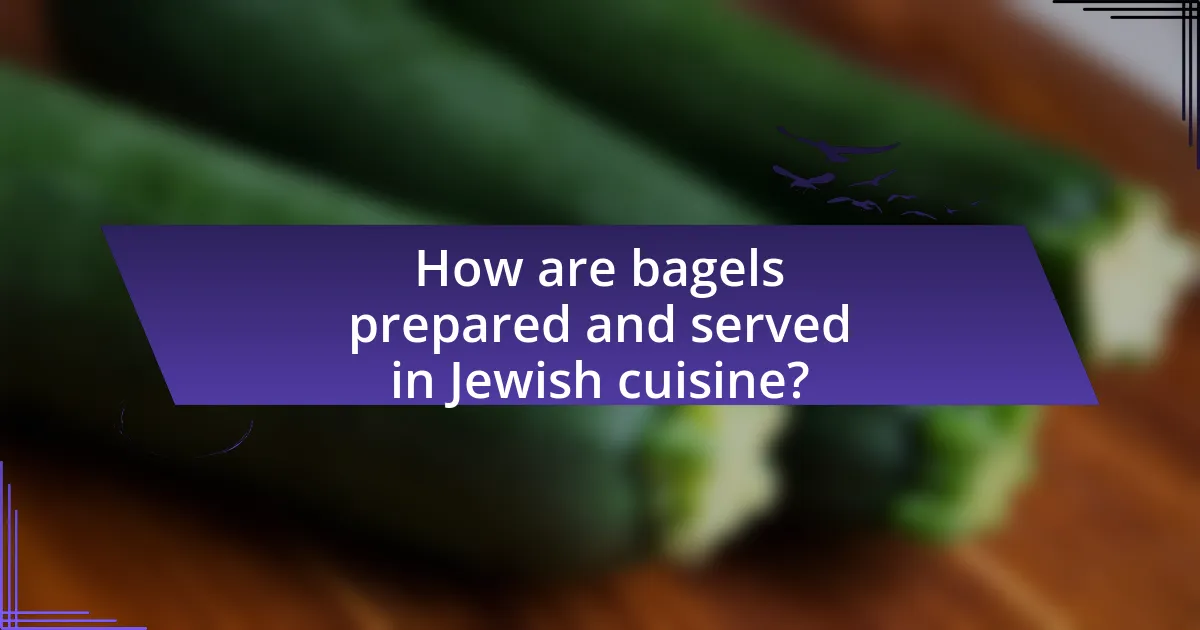Bagels are a significant element of Jewish culinary traditions, symbolizing community and continuity. Originating in Eastern Europe, particularly Poland, bagels have become integral to Jewish celebrations and rituals, often served during Shabbat and holidays. The article explores the historical development of bagels, their migration to the United States, and their evolving role in Jewish cuisine, including traditional preparation methods, popular toppings, and contemporary trends. Additionally, it highlights the cultural significance of bagels in Jewish identity and communal gatherings, as well as innovative adaptations in modern culinary practices.

What is the significance of bagels in Jewish culinary traditions?
Bagels hold significant cultural and culinary importance in Jewish traditions, symbolizing community and continuity. Historically, bagels originated in Eastern Europe, particularly among Jewish communities in Poland, where they were often served during special occasions and celebrations, such as Shabbat and holidays. The unique preparation method, which involves boiling the dough before baking, contributes to their distinctive texture and flavor, making them a staple in Jewish cuisine. Furthermore, bagels have evolved into a symbol of Jewish identity, often associated with Jewish delis and breakfast traditions in the United States, reinforcing their role in cultural heritage and communal gatherings.
How did bagels originate within Jewish culture?
Bagels originated within Jewish culture in Poland during the 16th or 17th century, evolving from a type of bread known as “bajgiel.” This bread was shaped into a ring, which was practical for boiling and baking, a method that contributed to its unique texture. Historical records indicate that bagels were given as gifts to women after childbirth, symbolizing a wish for a safe delivery. The bagel’s association with Jewish culture solidified as Jewish immigrants brought the tradition to the United States in the late 19th century, where it became a staple in Jewish delis and cuisine.
What historical events influenced the development of bagels?
The development of bagels was influenced by several historical events, notably the migration of Jewish communities from Eastern Europe to the United States in the late 19th and early 20th centuries. This migration brought traditional Jewish foods, including bagels, to American shores, where they began to gain popularity. The establishment of Jewish bakeries in cities like New York further solidified the bagel’s place in American cuisine. Additionally, the bagel’s association with Jewish cultural identity and its adaptation to American tastes contributed to its evolution and widespread acceptance. The first recorded mention of bagels in America dates back to 1880, highlighting their historical significance in the culinary landscape.
How did immigration shape the popularity of bagels?
Immigration significantly shaped the popularity of bagels by introducing them to diverse populations in the United States, particularly during the late 19th and early 20th centuries when Eastern European Jewish immigrants settled in urban areas. These immigrants brought their culinary traditions, including bagels, which quickly gained popularity among non-Jewish communities as well. The establishment of bagel bakeries in cities like New York City, where the Jewish population was concentrated, facilitated the spread of bagels beyond their cultural origins. By the mid-20th century, bagels became a staple in American diets, with their consumption rising dramatically; for instance, bagel sales in the U.S. increased from 1.5 million in 1980 to over 300 million by the late 1990s, illustrating their widespread acceptance and integration into American cuisine.
What role do bagels play in Jewish rituals and celebrations?
Bagels serve as a significant food item in Jewish rituals and celebrations, particularly during events such as Shabbat and Jewish holidays. Traditionally, bagels are often enjoyed with cream cheese and lox, symbolizing the importance of communal meals and hospitality in Jewish culture. During celebrations like weddings and bar or bat mitzvahs, bagels may be included in the spread, reflecting the cultural heritage and culinary practices of Jewish communities. The bagel’s round shape is also seen as a symbol of continuity and eternity, aligning with the themes of many Jewish rituals.
Which Jewish holidays prominently feature bagels?
Bagels prominently feature during Jewish holidays such as Rosh Hashanah and Yom Kippur. On Rosh Hashanah, bagels are often served as part of the festive meal, symbolizing the continuity of life and the cycle of the year. During Yom Kippur, bagels are commonly consumed during the break-fast meal after the day of fasting, providing a traditional and comforting food choice to conclude the observance. These practices highlight the cultural significance of bagels within Jewish culinary traditions during these important holidays.
How are bagels incorporated into traditional Jewish meals?
Bagels are commonly incorporated into traditional Jewish meals as a staple bread, often served with various toppings and accompaniments. In Jewish culinary traditions, bagels are frequently enjoyed with cream cheese and lox, particularly during breakfast or brunch. This combination reflects the cultural significance of bagels in Jewish communities, especially in Eastern European Jewish cuisine, where they originated. Historical records indicate that bagels were first mentioned in Poland in the 17th century, and they have since become a symbol of Jewish identity and culinary heritage.

How are bagels prepared and served in Jewish cuisine?
Bagels in Jewish cuisine are prepared by first boiling the dough in water, often with added malt or honey, before baking them to achieve a chewy texture and shiny crust. This method of preparation is rooted in tradition, with origins tracing back to Eastern European Jewish communities. Bagels are typically served sliced in half and can be topped with various spreads such as cream cheese, lox, or vegetables, reflecting the diverse culinary practices within Jewish culture. The combination of boiling and baking, along with the customary toppings, underscores the bagel’s significance as a staple in Jewish culinary traditions.
What are the traditional methods of making bagels?
Traditional methods of making bagels involve a specific process that includes mixing, boiling, and baking. The dough is typically made from high-gluten flour, water, yeast, and salt, which is kneaded until smooth. After the dough rises, it is shaped into rings. The key step is boiling the shaped bagels in water, often with added malt or honey, for about 30 seconds to a minute, which gives them their characteristic chewy texture. Finally, the bagels are baked in an oven until golden brown. This method has historical roots in Eastern European Jewish communities, where bagels were first popularized.
What ingredients are essential for authentic bagel recipes?
Essential ingredients for authentic bagel recipes include high-gluten flour, water, yeast, salt, and malt. High-gluten flour provides the necessary protein content for the bagel’s chewy texture, while water is crucial for hydrating the flour and activating the yeast. Yeast is the leavening agent that helps the dough rise, and salt enhances flavor and controls fermentation. Malt, often in the form of malt syrup or powder, contributes to the bagel’s characteristic sweetness and color during baking. These ingredients are foundational in traditional bagel-making, ensuring the final product aligns with historical Jewish culinary practices.
How does the boiling process affect the texture of bagels?
The boiling process significantly affects the texture of bagels by creating a chewy exterior and a dense interior. When bagels are boiled before baking, the high temperature gelatinizes the starches on the surface, forming a crust that retains moisture during baking. This results in a unique texture that is both firm and chewy, distinguishing bagels from other bread types. The boiling also contributes to the bagel’s characteristic shine and color, as the starches caramelize during the baking process.
What variations of bagels exist within Jewish communities?
Variations of bagels within Jewish communities include the classic plain bagel, sesame bagel, poppy seed bagel, onion bagel, garlic bagel, and everything bagel. Each variation reflects regional preferences and cultural influences; for instance, the everything bagel, topped with a mix of seeds and spices, is particularly popular in New York City, while the onion and garlic bagels are often favored in Eastern European Jewish traditions. The diversity in bagel types showcases the adaptability of Jewish culinary practices, influenced by local ingredients and tastes throughout history.
How do different regions influence bagel styles and flavors?
Different regions significantly influence bagel styles and flavors through variations in ingredients, preparation methods, and cultural preferences. For instance, New York bagels are known for their dense, chewy texture achieved by boiling them in water before baking, while Montreal bagels are smaller, sweeter, and often baked in wood-fired ovens, resulting in a crispier crust. Additionally, regional toppings and fillings reflect local tastes; for example, New York bagels frequently feature cream cheese and lox, whereas Montreal bagels may be topped with sesame or poppy seeds. These distinctions are rooted in the historical migration patterns of Jewish communities, which adapted their culinary practices to local resources and tastes, thereby shaping the unique bagel styles found in different areas.
What are some popular toppings and spreads for bagels?
Popular toppings and spreads for bagels include cream cheese, lox, butter, and various flavored spreads such as chive, vegetable, and smoked salmon. Cream cheese is the most traditional spread, often paired with lox, which is cured salmon, reflecting Jewish culinary traditions. Additionally, toppings like capers, red onions, and tomatoes complement these spreads, enhancing the flavor profile of the bagel. These combinations are widely recognized in Jewish cuisine, particularly in New York City, where bagels and their toppings have become iconic.
What contemporary trends are shaping the bagel’s role in Jewish cuisine?
Contemporary trends shaping the bagel’s role in Jewish cuisine include the rise of artisanal bagel shops, innovative flavor combinations, and the incorporation of health-conscious ingredients. Artisanal bagel shops, such as those in New York and Los Angeles, emphasize traditional methods while experimenting with unique toppings and fillings, reflecting a blend of cultural influences. Additionally, the introduction of flavors like everything bagels with gourmet toppings or seasonal ingredients showcases a shift towards creativity in bagel preparation. Health-conscious trends have also led to the use of alternative flours, gluten-free options, and plant-based spreads, catering to modern dietary preferences while maintaining the bagel’s cultural significance. These trends illustrate the bagel’s evolving role as both a traditional staple and a canvas for culinary innovation within Jewish cuisine.
How are modern interpretations of bagels evolving?
Modern interpretations of bagels are evolving through innovative flavors, toppings, and preparation methods. Chefs and bakers are experimenting with ingredients such as alternative flours, including gluten-free options, and incorporating unique flavors like matcha or activated charcoal. Additionally, traditional toppings are being reimagined; for instance, cream cheese is now offered in various gourmet flavors, and bagels are being served with non-traditional spreads like hummus or avocado. This evolution reflects a broader trend in culinary practices where cultural foods are adapted to contemporary tastes and dietary preferences, showcasing the bagel’s versatility beyond its historical roots in Jewish culinary traditions.
What innovative flavors and styles are being introduced?
Innovative flavors and styles being introduced in bagels include unique combinations such as everything bagels with spicy sriracha seasoning, matcha-infused dough, and sweet variations like blueberry and lemon zest. These innovations reflect a trend towards fusion cuisine, where traditional bagel recipes are enhanced with global flavors. For example, the introduction of savory toppings like kimchi or smoked salmon with cream cheese infused with wasabi showcases the blending of cultural culinary practices, appealing to a diverse palate.
How are bagels being integrated into fusion cuisine?
Bagels are being integrated into fusion cuisine by combining traditional bagel elements with diverse culinary influences, such as Asian, Mexican, and Mediterranean flavors. For example, chefs are creating bagel sushi rolls that incorporate raw fish and vegetables wrapped in a bagel instead of rice, and bagel tacos that use bagel halves as shells filled with various proteins and toppings. This integration reflects a growing trend where bagels serve as a versatile base for innovative dishes, appealing to a broader audience and enhancing the traditional bagel experience.
What practical tips can enhance the bagel experience?
To enhance the bagel experience, consider toasting the bagel for optimal texture and flavor. Toasting creates a crispy exterior while maintaining a chewy interior, which is essential for a satisfying bite. Additionally, pairing bagels with high-quality spreads, such as cream cheese or smoked salmon, elevates the overall taste. Research indicates that the combination of flavors and textures significantly enhances the enjoyment of bagels, as noted in culinary studies focusing on Jewish cuisine. Finally, experimenting with various toppings, such as capers or fresh vegetables, can add complexity and freshness, further enriching the bagel experience.
How can one choose the best bagel for different occasions?
To choose the best bagel for different occasions, consider the flavor profile and texture that complement the event. For breakfast gatherings, plain or everything bagels pair well with cream cheese and smoked salmon, enhancing the traditional Jewish breakfast experience. For casual lunches, sesame or poppy seed bagels can be filled with deli meats or salads, providing a satisfying meal. During festive occasions like Jewish holidays, opt for sweeter varieties such as cinnamon raisin bagels, which align with celebratory themes. The choice of bagel should reflect the culinary traditions and preferences of the attendees, ensuring a culturally resonant experience.
What are some recommended pairings for bagels to elevate meals?
Recommended pairings for bagels to elevate meals include cream cheese, smoked salmon, capers, and fresh vegetables. Cream cheese provides a rich, creamy texture that complements the chewy bagel, while smoked salmon adds a savory, umami flavor. Capers introduce a briny contrast, enhancing the overall taste profile. Fresh vegetables like tomatoes, cucumbers, and red onions add crunch and freshness, creating a balanced meal. These pairings are rooted in Jewish culinary traditions, where bagels are often served with these accompaniments, reflecting a harmonious blend of flavors and textures.



